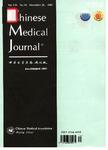Cochlear implantation effect on deaf children with gap junction protein beta 2 gene mutation
Cochlear implantation effect on deaf children with gap junction protein beta 2 gene mutation作者机构:Beijing Tongren Hospital Capital Medical University Beijing Institute of Otolaryngology Key Laboratory of Otolaryngology Head and Neck Surgery (Capital Medical University) Ministry of Education Beijing 100005 China China Rehabilitation Research Center for Deaf Children (CRRCDC) Beijing 100029 China
出 版 物:《Chinese Medical Journal》 (中华医学杂志(英文版))
年 卷 期:2013年第126卷第7期
页 面:1298-1301页
核心收录:
学科分类:1002[医学-临床医学] 100213[医学-耳鼻咽喉科学] 10[医学]
主 题:genetic connexin26 cochlear implant rehabilitation effect
摘 要:Background The popularization and promotion of gene diagnosis technology makes it possible to detect deafness genes for children with congenital hearing impairment, and the proportion of gap junction protein beta 2 (GJB2) gene mutations in cochlear implant patients is 26.5%. We did follow-up evaluation on auditory rehabilitation effect for all 31 deaf children with GJB2 gene mutation after cochlear implantation to provide a reference for such patients. Methods Application of "the genetic deafness gene chip detection kit" and "gene complete sequence analysis" were applied to conduct detection on common genetic deafness gene mutation hotspots of the hearing impaired children with cochlear implantation. To conduct auditory rehabilitation effect evaluation on all 31 cases of patients with GJB2 genetic deafness after 3, 6 and 12 months of the operation respectively. The single factor repeated measure analysis of variance (ANOVA) was applied to analysis whether there were significant difference among the results of initial consonant of a Chinese syllable recognition at 3 different stages after the operation, the results of vowel of a Chinese syllable recognition at 3 different stages after the operation, and the results of two-syllable recognition at 3 different stages after the operation. Results The 235delC is the high-incidence mutational site in 31 cases of patients with GJB2 genetic deafness, and the total detection rate is up to 90.3% (28/31). There were significant differences in the initial consonant and the vowel of a Chinese syllable recognition rate, and the two-syllable recognition rates at 3, 6, and 12 months after the operation (P 〈0.01). Conclusion Cochlear implantation is a safe and effective measure for auditory reconstruction, enabling patients with GJB2 hereditary severe sensorineural deafness to achieve auditory speech recognition effectively.



